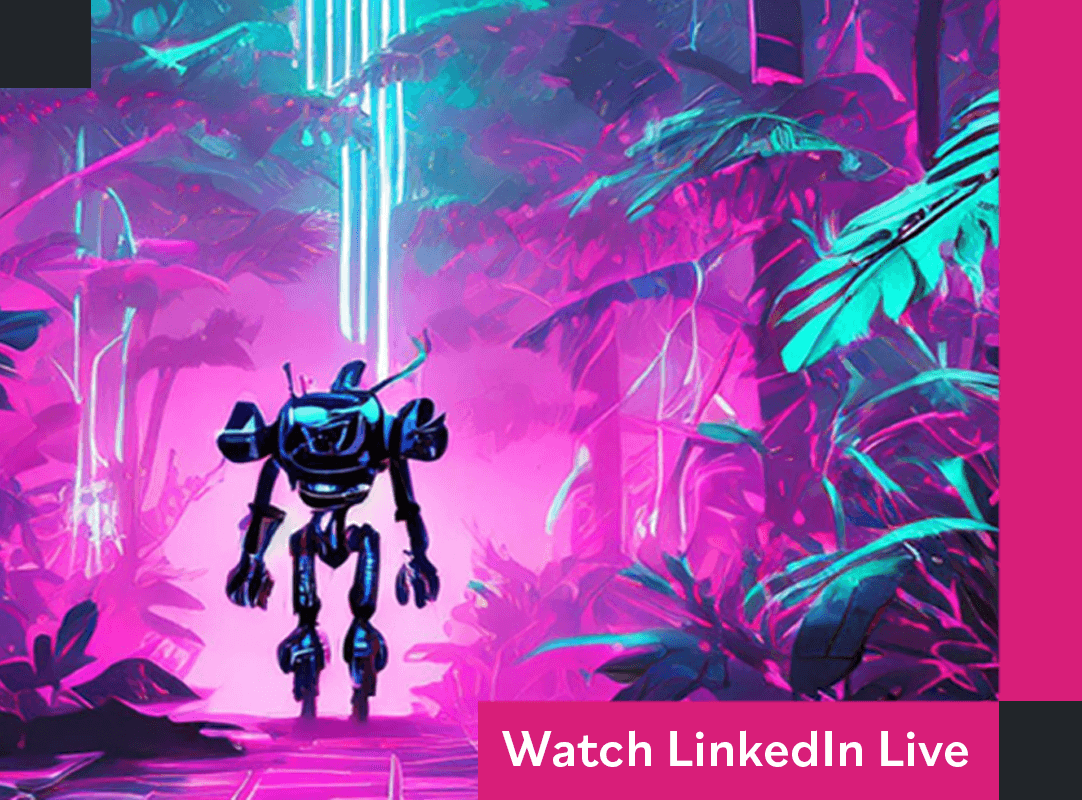“The creative challenge hasn't changed.” In a LinkedIn Live, our Creative Director explored how generative AI is transforming the way we create visuals for marketing and what the future might hold.
From pushing the boundaries of visual design to accelerating research, generative AI is already revolutionising the creative industries. But how can you separate the hype from the reality and what are the risks?
Formative’s Creative Director, Alex Martin, spoke to Laurence Denmark, Co-founder and Creative Director of Studio Miko, and Anthony Thornley, Founder and Creative Director of Day One Design, in a recent Formative LinkedIn Live event that explored how these tools are being used across the industry and where they might take us in the future.
Experimenting with caution
At Formative, creative specialists and working groups are keeping up to date with the latest developments in generative AI and what they mean for our business.
The technology is already speeding up research, streamlining project management and expanding our visual design capabilities. At this point in Gen-AI development, however, all tools require careful review and refinement to provide strong results.
It has been a similar story for Anthony and Lawrence. Both shared examples of how the technology can be used to enhance content creation, particularly by improving the quality and efficiency of image manipulation.
However, they also acknowledged the need for responsible usage, recognising the potential benefits and the flaws when it comes to introducing AI tools into workflows.
"This isn't a quick fix,” Laurence says. “You're kind of just giving the designers another tool to use to create imagery, so it empowers designers, but we have to use it with caution."
Bringing clients with you
Anthony highlighted the importance of discussing with clients the nuances of using AI in visual content creation, and managing expectations around its capabilities. While AI – as a developing technology – can provide viable alternatives to traditional methods, it isn't yet a perfect solution, and requires clear communication from all parties, he said.
“The way that we try and sell this isn’t ‘this is going to save you money or time’,” he said. “Instead, we might be able to come up with something truly unique, and that doesn't require a photo shoot or to get lots of people to the same place, which can be costly.”
Processes must evolve
Agencies must look inward if they are to make the most of these technologies, the panellists said.
Internal processes will need to evolve to fit the latest tools on offer.
“It's a totally different workflow to what we were previously used to, by way of prompting in and using reference imagery,” Alex explained.
“But the extent of the creative challenge itself hasn't changed that much. You're still having to continuously refine and check what you're doing, and you're not necessarily saving a huge amount of time. It's just a different way of getting to that end result.”
Great results still require expertise
During the session, audience members shared their questions with the panel. One person asked how best to balance the leveraging of AI tools for efficiency with maintaining human touch on design.
Anthony emphasised the importance of a creative's expertise in utilising AI effectively, cautioning that untrained individuals may struggle with its complexities. He suggested that, at this stage, the best results are achieved by creatives with a deep understanding of the field.
Laurence echoed this sentiment, noting that AI shifts the focus from craft to strategy and art direction, stressing the need for thoughtful consideration and decision-making when generating new content.
“You need to come up with the idea first, and allow the AI to do the heavy lifting at the back end of it for you, rather than seeing what AI can come up with and then formulating your idea around that,” he said.
“The best way to create meaningful content that's going to engage with the audiences you're trying to reach is to do it the old-fashioned way. Understand what it is you're really trying to talk about first, and then use the AI visual generators to help you produce that.
“The idea has to come first, not the other way around.”
Focus on the future
The panellists also shared their excitement about the future.
“I believe the hype,” said Laurence. “I think we’re at quite a pivotal moment in technology, but also human civilization in general.”
Recent text-to-video footage produced by Open AI’s Sora, for example, has made Laurence optimistic about AI’s potential to generate B-Roll: “It is going to be quite incredible, even if it's not quite there yet.“
Anthony was more cautious: “I'm probably a bit more sceptical about how great it [Sora] will be – especially at its launch stage.
“I think we need to see public use cases of it to make a proper judgement, because I don't think it'd be any surprise that Open AI has released some gorgeous-looking videos.”
As we venture further into the realm of generative AI, one thing remains clear: the fusion of human creativity and technological innovation is set to reshape much of what we do, and its true potential for marketing visuals is yet to be seen.
“It's a bit of a wait-and-see,” said Anthony.
READ MORE
From corporate podcasts to AI: Here are the next B2B content trends in 2023
Generative AI: The now, and the future
Author: Gareth Francis
